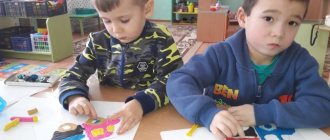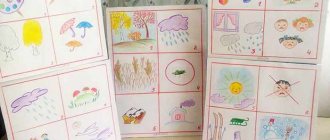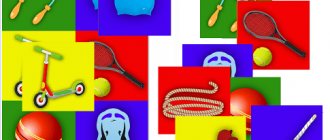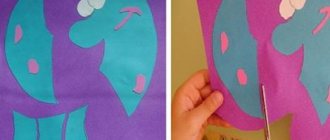Project “Construction from waste material with children of senior preschool age”
Irina Toshcheva
Project “Construction from waste material with children of senior preschool age”
Project : “ Construction from waste material with children of senior preschool age ”
Introduction
The problem of developing interest in design in preschool children occupies a significant place in preschool pedagogy . Since a variety of constructive creativity gives children the opportunity not only to explore the world around them, but also to comprehensively develop their abilities. The relevance of the problem of conducting design classes in preschool institutions is that at this stage of the development of society, fewer hours are devoted to design children than other disciplines (language, mathematics , drawing, etc.)
Construction in the learning process is a means of deepening and expanding the acquired theoretical knowledge and developing creative abilities and inventive interests.
construction itself (from the Latin construo - I build, create)
denotes construction in general, bringing various objects, parts, elements into a certain relative position and the process of creating a model, machine, structure, technology with the implementation of
projects and calculations .
Children's design refers to the process of constructing buildings, such structures , which provide for the relative arrangement of parts and elements, and methods for connecting them. As a rule, the design takes place in the form of a game in order to interest the preschooler .
Children's artistic creativity from waste material allows them to develop not only artistic taste and creative imagination, but also forms the foundations of ecological culture.
The world of things around us is very diverse. These are plastic bottles, corks, cases, boxes, buttons, beads, etc.
We adults try to quickly get rid of it and throw it away , but it turns out that these items can be given a second life if you invest imagination and imagination and teach this to children.
An already used bottle item is not thrown away, but is turned into a useful item or craft.
The task of an adult is to reveal the creative potential of each child, to teach him to feel a sense of satisfaction from the result of his work.
There is one step from a craft to a work of art.
Purpose: To study the possibility of using waste material in working with preschool children .
Tasks:
Educational
— Introduce children to waste materials .
— Develop the ability to follow oral instructions.
— Teach various techniques for working with waste material .
— Introduce children to basic geometric concepts: circle, square, triangle, angle, side, vertex, etc. Enrich the child’s vocabulary with special terms.
— Create compositions with products made using the origami technique.
Educational:
— Develop fine motor skills, hand coordination, eye control.
— Develop attention, memory, thinking and imagination.
— Develop artistic taste, creativity and imagination of children.
— Develop spatial imagination.
Educational:
— Cultivate interest in designing from waste materials .
— Expand children’s communication abilities.
— Form a work culture and improve work skills.
— Contribute to the creation of play situations, expand children’s communication abilities.
— Encourage children to engage in joint search activities;
— Form an idea of safety rules when working with scissors, glue, etc.
For successful and safe work with preschoolers , safety precautions should be carried out when working with scissors:
1. The scissors should be stored in the specified place in a certain position.
2. When working, you must carefully monitor the cutting direction.
3. Do not work with blunt scissors or loose hinges.
4. You cannot hold scissors with the blade facing up.
5. Do not leave scissors with open blades.
6. You cannot cut with scissors on the go.
7. You cannot approach a friend while working.
8. Closed scissors should be passed rings first.
9. While working, you must hold the material with your left hand so that your fingers are away from the blade.
Safety precautions when working with glue:
1. The glue should be handled with care. Glue is poisonous!
2. Apply glue to the surface of the product only with a brush.
3. Do not let glue get on your fingers, face, especially eyes.
4. If glue gets into your eyes, rinse them immediately with plenty of water.
5. After finishing work, be sure to wash your hands and arms.
6. When working with glue, you should use a napkin
Planning work on construction from waste material
No. Lesson Materials
JANUARY
1. Composition “Spiders on a Cobweb”
A box of chocolates, white threads, bright-colored cardboard, 3 walnut shells, 3 pistachio shells, wire, cotton wool, glue, scissors.
2. Composition “Body”
A two-liter plastic container, a button with two holes, wire, an awl, scissors.
3. Composition “Toy-trap”
The upper part of a two-liter container with a stopper, wire, a Kindersurprise container, strong thread, 2 beads for the eyes and 1 elongated one for the nose, self-adhesive colored paper, scissors, an awl, a felt-tip pen.
FEBRUARY
1. Composition “Worm in an Apple”
Thick cardboard, colored paper, multi-colored beads, wire, glue, a round cheese box, a glue brush, scissors, an awl, a simple pencil.
2. Composition “Aquarium”
Plastic container 5l and 2l, plastic lid or thick cardboard, equal in diameter to a large container, used plasticine (mixed by color, previously used, yellow plasticine, shells, small pebbles, tape, scissors, felt-tip pen.
3. Panel “To grandma for tea”
Matches, salt dough, 3 candy wrappers, gouache, brush, thick cardboard, stacks, PVA glue, ruler, pencil.
4. Composition “Sunflower”
Round box of processed cheese, yellow and green colored paper, yellow and brown plasticine, sunflower seeds, 2 walnut shells, snail shell, wire, 2 yellow beads, 2 toothpicks, glue, glue brush, stack, gouache, scissors.
MARCH
1. Composition “Caterpillar”
5 containers of chocolate eggs, 5 identical beads of any color, 2 blue beads for the eyes and 1 red for the mouth, wire, pieces of fur, glue, scissors, an awl.
2. Composition “Cork Man”
8 multi-colored juice caps, 23 plastic bottle caps, chocolate egg halves, a large chocolate egg container, 4 long wires, 2 short ones, 2 white buttons, 2 black beads for the eyes and a red one for the mouth, an awl, scissors, crochet hook.
3. Composition “Horse”
A whole container and half of a large chocolate egg, 4 halves of containers of small chocolate eggs, 6 multi-colored juice caps, 19 multi-colored stoppers, black and red beads, a black button, red thread, wire, an awl, scissors, a crochet hook.
4. Composition “Cat and Mouse”
A container for a large chocolate egg, small stoppers, 5 juice caps, 4 tube caps, 2 white buttons, 2 blue and green beads, 1 red bead, wire.
When drawing up the work plan, the following principles were observed:
• availability of material , reliability;
• seasonality;
• sequences;
• presenting material from simple to complex;
• transition of quantitative changes into qualitative ones.
Classes were held twice a week, during NOD and in the afternoon. The duration of the lesson is 15-20 minutes.
To develop fine motor skills and maintain interest in designing from waste materials, the group was additionally equipped with a “corner for experimentation and research” waste materials.
, in the equipment of which parents took part.
The corner was equipped with the following materials : paper of different quality and color, fabric, foam rubber, threads, wire, pieces of wood, plastic bottles, caps, buttons, colored glass, stones, newspapers, candy wrappers, paper clips, plant seeds, pine cones, acorns, shells, sawdust, collections of shells, stones, beads, drawing supplies, plasticine, brushes, cotton swabs, sippy cups, etc.
All material in the “corner”
dynamic, simple, cheap and accessible, which is important in today’s difficult financial situation.
Thus, conditions were created for independent construction from waste material in your free time .
There is no doubt that all developmental work should take place in close cooperation with parents. In order to attract parents to this work, we held consultations , meetings, as well as joint classes, at which recommendations were given for working with waste material .
During the work, various classes were held in the technology of designing from waste material . At the same time, the structure of the lesson and rules were observed, and the program content gradually became more complex. The work was carried out in subgroups, which gave children the opportunity to freely act with objects: examine them, slowly reflect on their actions. We used materials that are not often used in a group with a large number of children (buttons, lids, stones, paints, sand, etc.)
Children were not limited in their activities for hygienic reasons (
“you’ll get dirty”
,
“you’ll spill”
). The classes were conducted in a playful way. Thus, in the process of work, children unobtrusively gained knowledge and acquired the necessary skills.
The teacher was assigned the role of an accomplice in children's creativity, who is not in a hurry to show them the way to solve problems or problems, but tactfully supports the child on the path of independent search. Currently, working with children requires a democratic style from the teacher, so communication with children during construction was confidential and friendly.
As a result of the work, the children expanded their understanding of waste material and learned to make many useful crafts from various waste materials .
The children enjoyed designing , in class and in their free time, helping, prompting each other, asking to be taught how to make other crafts, which they then used in games, dramatizations of fairy tales, and simply gave as gifts to their parents and each other. During collective work, children learned to divide into subgroups and be friendly to each other.
The work carried out aroused great interest among the children. As a result, the children received a lot of positive emotions. The children's crafts turned out to be bright and unusual.
The work took place in close cooperation with parents. Adults became active participants in the work; they helped their children in making crafts.
As a result, both children and parents have increased interest in working with waste material .
Good traditions
The tradition of making crafts from waste materials dates back to time immemorial. Let us at least remember the dolls our grandmothers played with: a block of wood with painted eyes and a handkerchief, boats made from a piece of birch bark, dogs made from acorns. In Soviet pedagogy, significant attention was also paid to working with available material. Unfortunately, at present, this type of creativity is not as popular as, for example, paintings by numbers, diamond embroidery, designer dolls.
Rather, you will have to do the making of crafts from waste materials with your own hands on the instructions of the child’s educator or teacher. And in vain! Not only does working with what we always have at hand require virtually no financial outlay, this activity is very useful for both children and adults.
Interior items
Adults enjoy making various interior items and household appliances. It can be:
- lamps and decorative lamps;
- figurines, photo frames, amulets, figurines;
- devices for storing keys and jewelry;
- gifts, souvenirs, interior decorations.
It’s a pleasure to give beautiful handicrafts made from waste materials to loved ones. Such gifts are especially touching and valuable, because they contain a piece of the soul and warmth of a loved one.
"Soulful" benefits
As already noted, both adults and children enjoy making crafts from waste materials. For adults, this type of activity is a kind of relaxation - such creativity calms the nerves, helps realize creative abilities and needs, and helps achieve inner peace and harmony.
In addition, recycling materials helps preserve the environment and reduces waste.
Why is this necessary?
It is not always the case that “junk” creativity is used only for kindergarten and school exhibitions and then mercilessly destroyed. If you look at photos of crafts made from waste material on the Internet, you can simply be amazed at their diversity, beauty and practicality.
These include exclusive interior items, souvenirs, gifts - hand made is now very popular and in demand.
Benefits of work
Any activity develops creativity. Creativity develops imagination, perseverance, and trains fine motor skills. In addition, children learn about the world around them not from pictures, but from what is called “by touch.”
Anything can be used as waste material: fabrics, natural materials, lids, wire - there is a variety of structures, and this is always very useful and instructive for a child.
Operating procedure
The techniques for making crafts from waste materials are very different. In general, the sequence of work depends on what kind of material you have to work with. If these are plastic bottles and dishes, then they must be cleanly washed and dried. Fabrics must be pre-washed and ironed. The natural material is dried.
Note!
Crafts for February 23: master class on creating interesting DIY crafts for Defender of the Fatherland Day
DIY crafts for February 14th step by step: a master class for beginners, with a description of how to make a craft for St. Valentine's Day. Valentina (140 photos)
Crafts made from jute: 100 photos of beautiful options. Easy instructions with photos and descriptions on how to make a craft with your own hands
When working, it is necessary to pay attention to safety, namely: if a child picks up waste material, then you need to make sure that there are no cracks, chips, or sharp corners so that the child does not get hurt.
Subject paintings
Older children can make more complex craft compositions, plot paintings, and illustrations for fairy tales. Children often do big jobs in groups.
Such activities help to establish relationships in a team, teach cooperation, mutual understanding and mutual assistance. Interesting narrative crafts made from waste material for exhibitions are always very interesting and receive a lot of praise and awards.





